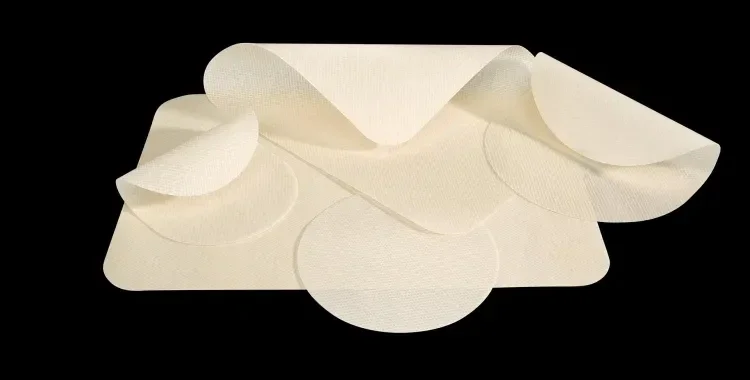
GORE® SYNECOR Intraperitoneal Biomaterial
Tri-layer material innovation
GORE® SYNECOR Intraperitoneal Biomaterial achieves positive outcomes with a unique combination of innovative materials, forming a hybrid solution for intraperitoneal repair.
This innovative tri-layer hybrid solution retains its strength for the life of the device and designed to support a single, effective repair in complex patients (VHWG 2).1 It is intended for use in ventral/incisional hernias that may require the addition of a non-absorbable reinforcing or bridging material. The device is designed for ease of use during minimally invasive (laparoscopic, robotic) and open surgical procedures.
Rapid vascularisation and tissue ingrowth2
The parietal layer, poly(glycolide:trimethylene carbonate) copolymer (PGA:TMC) Web Scaffold (Gore 3D PGA:TMC Web Scaffold) enhances tissue response and is designed to promote rapid cell migration and vascularization.* Tissue ingrowth is present throughout the Gore 3D PGA:TMC Web Scaffold around the knit fibres and within the scaffold. The non-porous PGA:TMC film layer provides intra-abdominal protection, reducing risk of adhesion formation.*,3
Permanent strength
The mid-layer is a macroporous knit of dense, monofilament PTFE fibres. This latest generation PTFE fibre is strong, compliant and is designed with a fibre diameter similar to lightweight mesh but with the strength of heavyweight mesh. The macroporous knit of dense, monofilament PTFE fibres may reduce the risk of bacterial adherence4 and along with increased vascularity5 may aid in the overall treatability of the device to minimise the need for removal if postoperative infection were to occur.†
* Data on file 2015; W. L. Gore & Associates, Inc; Flagstaff, AZ.
† Data on file 2022; W. L. Gore & Associates, Inc; Flagstaff, AZ.
- Ventral Hernia Working Group, Breuing K, Butler CE, et al. Incisional ventral hernias: review of the literature and recommendations regarding the grading and technique of repair. Surgery 2010;148(3):544-558.
- Crawford N. Assessment of Vascularity via Micro CT in Various Patch Devices. Flagstaff, AZ: W. L. Gore & Associates, Inc; 2016. [Final study report]. 2344TL.
- Matthews BD. Absorbable and nonabsorbable barriers on prosthetic biomaterials for adhesion prevention after intraperitoneal placement of mesh. International Surgery 2005;90(3)Supplement:S30-S34.
- Clinger L. PTFE Knit Microbial Placement. Flagstaff, AZ; W. L. Gore & Associates, Inc; 2018. [Work plan]. WP110158.
- Holt DJ, Grainger DW. Host response to biomaterials. In: Hollinger JO, ed. An Introduction to Biomaterials. 2nd ed. Boca Raton, FL: CRC Press; 2012;6:91-118.
22642161-EN
